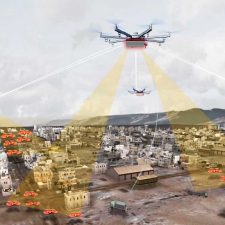Above: DARPA’s concept of an aerial dragnet for drones.
Since the launch of the Sputnik satellite in 1957 the Defense Advanced Research Projects Agency, DARPA, has investigated and created breakthrough technologies for national security. Their achievements include not only game-changing military capabilities such as precision weapons and stealth technology, but also such icons of modern civilian society such as the Internet, automated voice recognition and language translation, and Global Positioning System receivers small enough to embed in consumer devices.
Their latest goal is to develop a system for the detection of small drones, or unmanned aerial systems (UAS). Over the last two years we have seen how they can intrude into the airspace over wildfires, requiring the grounding of firefighting aircraft.
As the price of an off-the-shelf UAS decreases, they become easier to fly and are more adaptable for terrorist or military purposes, U.S. military forces will increasingly be challenged by the need to quickly detect and identify such craft — especially in urban areas, where sight lines are limited and many objects may be moving at similar speeds.
 To achieve the technically difficult goal of mapping small UAS in urban terrain, last week DARPA announced its Aerial Dragnet program. The program seeks innovative technologies to provide persistent, wide-area surveillance of all UAS operating below 1,000 feet in a large city. While Aerial Dragnet’s focus is on protecting military troops operating in urban settings overseas, the system could ultimately find civilian application to help protect U.S. metropolitan areas from UAS-enabled terrorist threats.
To achieve the technically difficult goal of mapping small UAS in urban terrain, last week DARPA announced its Aerial Dragnet program. The program seeks innovative technologies to provide persistent, wide-area surveillance of all UAS operating below 1,000 feet in a large city. While Aerial Dragnet’s focus is on protecting military troops operating in urban settings overseas, the system could ultimately find civilian application to help protect U.S. metropolitan areas from UAS-enabled terrorist threats.
“Commercial websites currently exist that display in real time the tracks of relatively high and fast aircraft—from small general aviation planes to large airliners—all overlaid on geographical maps as they fly around the country and the world,” said Jeff Krolik, DARPA program manager. “We want a similar capability for identifying and tracking slower, low-flying unmanned aerial systems, particularly in urban environments.”
Although several systems are being developed for tracking small UAS by extending surveillance methods used in open areas where large line-of-sight buffers mitigate the threat, these systems are impractical for operation in urban terrain. Aerial Dragnet seeks to leapfrog these approaches by developing systems adapted to the fundamental physics of small UAS in urban environments that could enable non-line-of-sight (NLOS) tracking and identification of a wide range of slow, low-flying threats.
The program seeks an array of innovative approaches, but notionally envisions a network of surveillance nodes, each providing coverage of a neighborhood-sized urban area, perhaps mounted on tethered or long-endurance UAS. Using sensor technologies that can look over and between buildings, the surveillance nodes would maintain UAS tracks even when the craft disappear from sight around corners or behind objects.
The output of the Aerial Dragnet system would be a continually updated common operational picture (COP) of the airspace at altitudes below where current aircraft surveillance systems can monitor, disseminated electronically to authorized users via secure data links. Because of the large market for inexpensive small UAS, the program will focus on combining low cost sensor hardware with software-defined signal processing hosted on existing UAS platforms. The resulting surveillance systems would thus be cost-effectively scalable for larger coverage areas and rapidly upgradable as new, more capable and economical versions of component technologies become available.
DARPA’s Aerial Dragnet program seeks teams with expertise in sensors, signal processing, and networked autonomy to achieve its goal. A solicitation detailing the goals and technical details of the program is on FedBizOps.
In a related effort, the U.S. Air Force is requesting proposals for a portable system to detect, identify and defeat a UAS.

